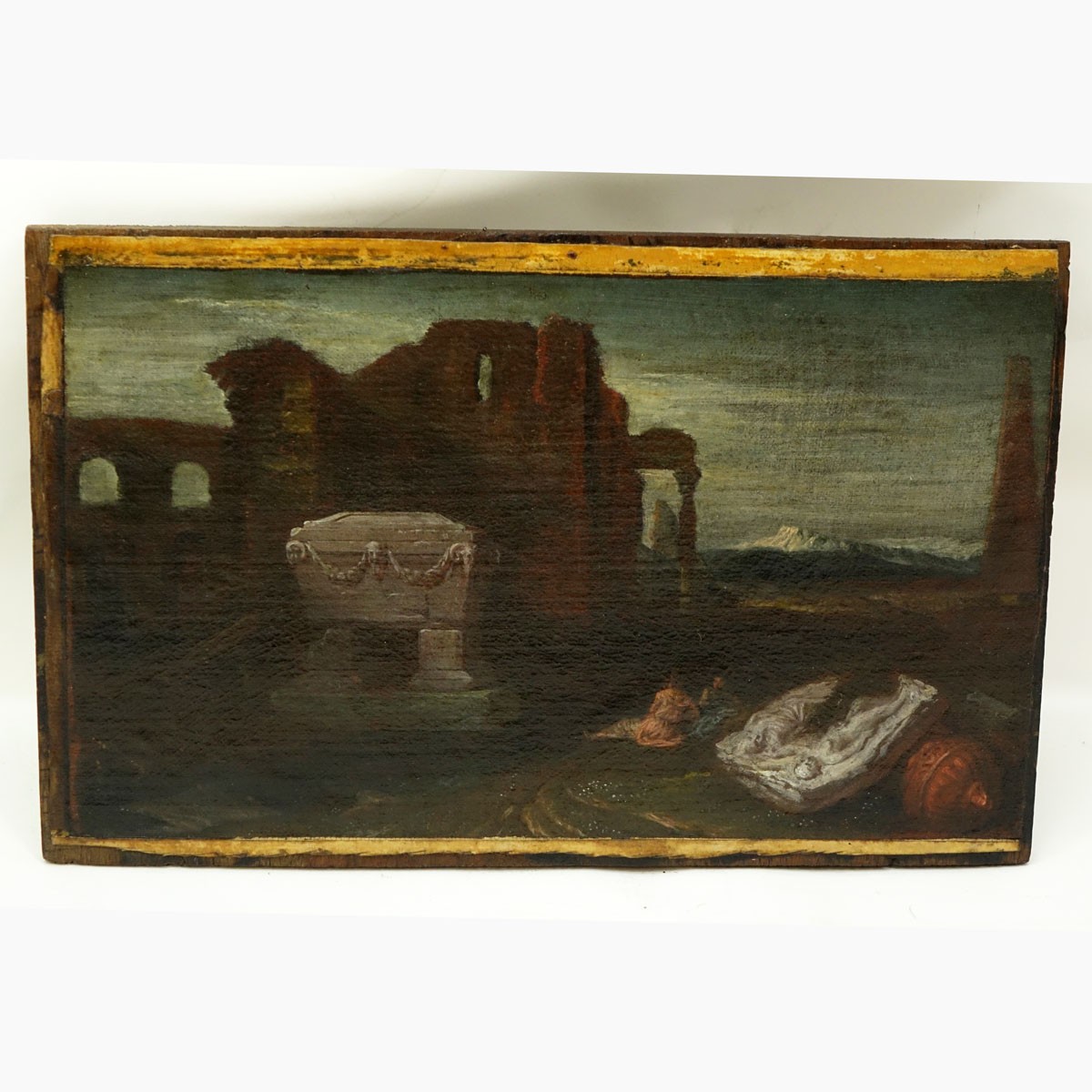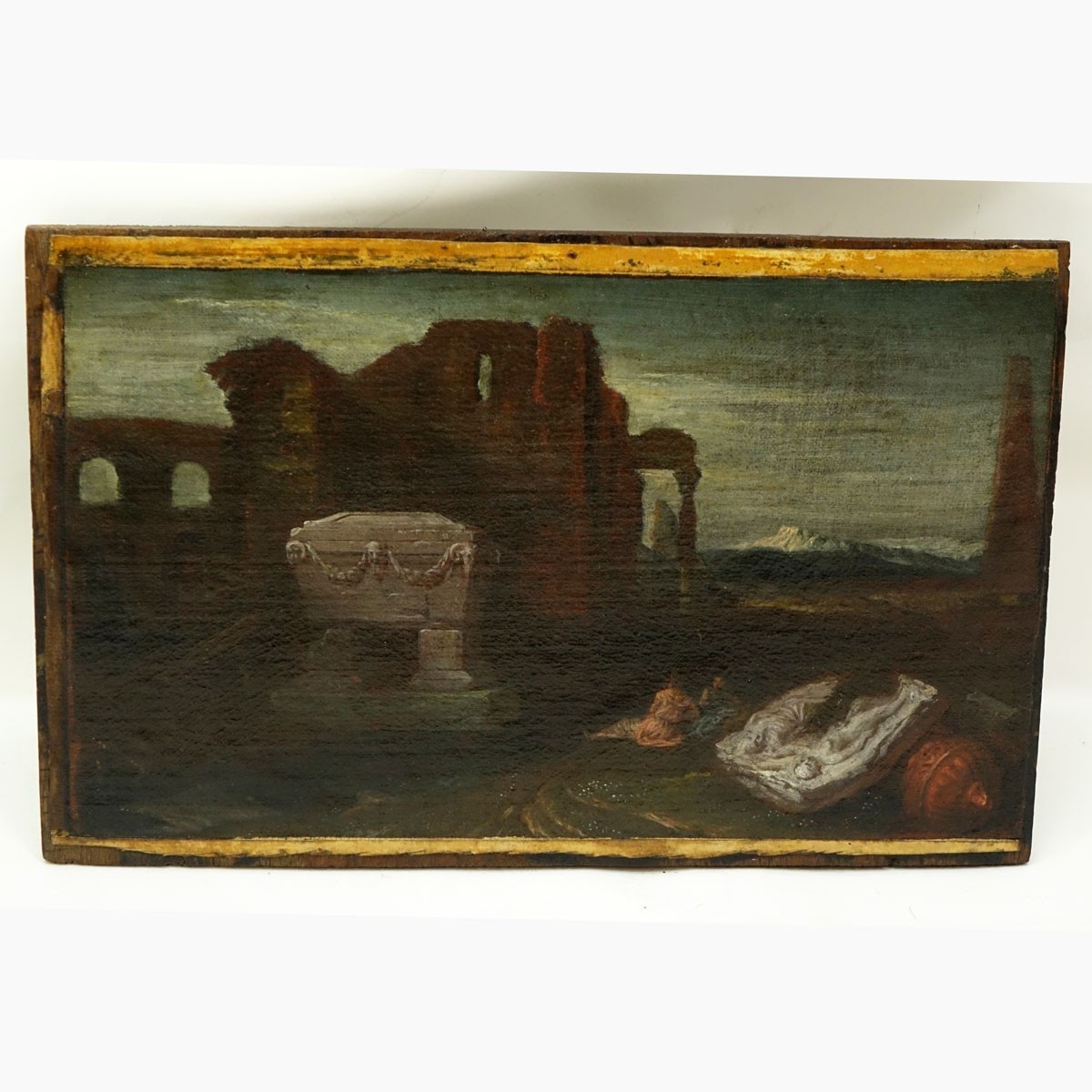Giovanni Paolo Panini Italian, circa 1692-1765 An Architectural Capriccio with the Roman Pantheon, the Column of Trajan, the Equestr... Italian, circa 1692-1765 An Architectural Capriccio with the Roman Pantheon, the Column of Trajan, the Equestrian Statue of Marcus Aurelius and other Roman Monuments Signed J.P. Panini and dated Roma 1738 (ll) Oil on canvas 38 1/4 x 53 3/4 inches (97.2 x 136.5 cm) Provenance: Wildenstein & Co., Inc., New York Private collection Sale, Parke-Bernet Galleries Inc., New York, Feb. 12, 1970, (part) Acquired from the above Private collection, New York, from 1970 until the present Giovanni Paolo Panini studied set design in Bologna before moving to Rome in 1717. After a brief period in the workshop of the Florentine painter Benedetto Luti he began to receive commissions to decorate Roman villas and palaces with frescos. Later he taught both at the Academia di San Luca and at the Academie Francaise. Taking note of the increasing number of English gentlemen arriving in Rome on the Grand Tour, Panini soon began to paint views of the city's ancient buildings and sculpture for this cultivated clientele. Although he depicted the individual monuments with great accuracy, his settings for them were imaginary, designed to charm rather than to describe. Thus he became the father of the type of picture known as the capriccio--a whimsical landscape with ruins, enlivened with figures. These paintings exerted a powerful influence on such later artists as Canaletto, Piranesi, Hubert Robert and Fragonard. The two works offered here are classic capriccios of Roman monuments, probably conceived as a pair. Both are signed and dated--a rarity in Panini's work. They have remained in a single private collection since 1970. Estate of a New York Gentleman
Glue relined. There is a small scrape in the lower left quadrant. The piece is In generally sound condition, with scattered touches of inpainting -- including some inpainted cracks -- in the sky and in some of the brown areas of the foreground. There are touches of inpainting in the foliage in the upper right quadrant, and some strengthening in the shadows of the architecture. The cloak of the statue of St. Peter atop the Column of Trajan shows an area of inpaint. The painting has not been restored since it was purchased in 1970.
Giovanni Paolo Panini Italian, circa 1692-1765 An Architectural Capriccio with the Roman Pantheon, the Column of Trajan, the Equestr... Italian, circa 1692-1765 An Architectural Capriccio with the Roman Pantheon, the Column of Trajan, the Equestrian Statue of Marcus Aurelius and other Roman Monuments Signed J.P. Panini and dated Roma 1738 (ll) Oil on canvas 38 1/4 x 53 3/4 inches (97.2 x 136.5 cm) Provenance: Wildenstein & Co., Inc., New York Private collection Sale, Parke-Bernet Galleries Inc., New York, Feb. 12, 1970, (part) Acquired from the above Private collection, New York, from 1970 until the present Giovanni Paolo Panini studied set design in Bologna before moving to Rome in 1717. After a brief period in the workshop of the Florentine painter Benedetto Luti he began to receive commissions to decorate Roman villas and palaces with frescos. Later he taught both at the Academia di San Luca and at the Academie Francaise. Taking note of the increasing number of English gentlemen arriving in Rome on the Grand Tour, Panini soon began to paint views of the city's ancient buildings and sculpture for this cultivated clientele. Although he depicted the individual monuments with great accuracy, his settings for them were imaginary, designed to charm rather than to describe. Thus he became the father of the type of picture known as the capriccio--a whimsical landscape with ruins, enlivened with figures. These paintings exerted a powerful influence on such later artists as Canaletto, Piranesi, Hubert Robert and Fragonard. The two works offered here are classic capriccios of Roman monuments, probably conceived as a pair. Both are signed and dated--a rarity in Panini's work. They have remained in a single private collection since 1970. Estate of a New York Gentleman
Glue relined. There is a small scrape in the lower left quadrant. The piece is In generally sound condition, with scattered touches of inpainting -- including some inpainted cracks -- in the sky and in some of the brown areas of the foreground. There are touches of inpainting in the foliage in the upper right quadrant, and some strengthening in the shadows of the architecture. The cloak of the statue of St. Peter atop the Column of Trajan shows an area of inpaint. The painting has not been restored since it was purchased in 1970.






.jpg)
.jpg)







Try LotSearch and its premium features for 7 days - without any costs!
Be notified automatically about new items in upcoming auctions.
Create an alert